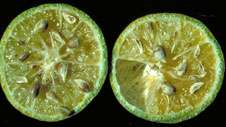Researchers develop new tool to characterise disease epidemics in trees

A University of Otago researcher and overseas colleagues have developed an innovative approach to modelling outbreaks of citrus greening, a devastating bacterial disease that has caused more than US$4.5 billion in lost citrus production in Florida alone in recent years.
The researchers' model allows characterisation of the disease process, even when epidemiological data are limited due to the presence of control measures.
The model can also be used to simulate how the disease will spread over time in particular conditions, allowing growers to calculate the economic costs and benefits of various disease control measures. Their findings appear online this week in the early edition of the leading US journal PNAS.
Citrus greening, also known as Huanglongbing (HLB), has inflicted increasingly severe economic losses on growers in some of the world's key citrus-growing areas. Insects called psyllids act as vectors for the disease, spreading a bacterial infection between trees when they feed. There is currently no cure for HLB and trees showing signs of infection have to be destroyed.
Lead author of the study, Dr Matthew Parry of the Department of Mathematics & Statistics, says that efforts to learn more about the pattern of the spread of such vector-borne diseases have been hampered by growers' understandable desire to swiftly control outbreaks.
"Now we have developed an epidemic model which can take into account the effect of control measures in HLB outbreaks, we can show how effective different types of control will be, and predict worst case scenarios," Dr Parry says.
The researchers, who included colleagues from leading institutions in the UK and the US, drew on an extensive dataset involving more than 250,000 trees in an affected plantation in South Florida to build their model.
"As New Zealand's primary industries are very vulnerable to biological hazards, we believe that this kind of tool has good potential for developing strategies to tackle emerging vector-borne disease threats."
More information: The paper is available online: www.pnas.org/content/early/201 … 997111.full.pdf+html
Journal information: Proceedings of the National Academy of Sciences
Provided by University of Otago











